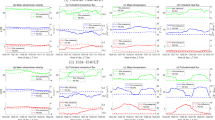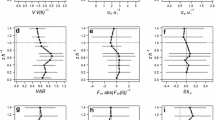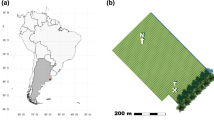Abstract
This study investigates the organised motion near the canopy-atmosphere interface of a moderately dense spruce forest in heterogeneous, complex terrain. Wind direction is used to assess differences in topography and surface properties. Observations were obtained at several heights above and within the canopy using sonic anemometers and fast-response gas analysers over the course of several weeks. Analysed variables include the three-dimensional wind vector, the sonic temperature, and the concentration of carbon dioxide. Wavelet analysis was used to extract the organised motion from time series and to derive its temporal scales. Spectral Fourier analysis was deployed to compute power spectra and phase spectra. Profiles of temporal scales of ramp-like coherent structures in the vertical and longitudinal wind components showed a reversed variation with height and were of similar size within the canopy. Temporal scales of scalar fields were comparable to those of the longitudinal wind component suggesting that the lateral scalar transport dominates. The existence of a – 1 power law in the longitudinal power spectra was confirmed for a few cases only, with a majority showing a clear 5/3 decay. The variation of effective scales of organised motion in the longitudinal velocity and temperature were found to vary with atmospheric stability, suggesting that both Kelvin-Helmholtz instabilities and attached eddies dominate the flow with increasing convectional forcing. The canopy mixing-layer analogy was observed to be applicable for ramp-like coherent structures in the vertical wind component for selected wind directions only. Departures from the prediction of m = Λ w L −1 s = 8–10 (where Λ w is the streamwise spacing of coherent structures in the vertical wind w and L s is a canopy shear length scale) were caused by smaller shear length scales associated with large-scale changes in the terrain as well as the vertical structure of the canopy. The occurrence of linear gravity waves was related to a rise in local topography and can therefore be referred to as mountain-type gravity waves. Temporal scales of wave motion and ramp-like coherent structures were observed to be comparable.
Similar content being viewed by others
References
Amiro B (1990) Comparison of turbulence statistics within three boreal forest canopies. Boundary-Layer Meteorol 51:99–121
Baldocchi D, Meyers T (1988a) A spectral and lag-correlation analysis of turbulence in a deciduous forest canopy. Boundary-Layer Meteorol 45:31–58
Baldocchi D, Meyers T (1988b) Turbulence structure in a deciduous forest. Boundary-Layer Meteorol 43:345–364
Bergström H, Högström U (1989) Turbulent exchange above a pine forest. II. Organized structures. Boundary-Layer Meteorol 49:231–263
Brunet Y, Collineau S (1994). Wavelet analysis of diurnal and nocturnal turbulence above a maize canopy. In: Foufoula-Georgiou E, Kumar P (eds). Wavelets in geophysics, Vol.4 of Wavelet analysis and its applications. Academic Press, San Diego, pp. 129–150
Brunet Y, Irvine M (2000) The control of coherent eddies in vegetation canopies: streamwise structure spacing, canopy shear scale and atmospheric stability. Boundary-Layer Meteorol 94:139–163
Caughey S (1977) Boundary-layer turbulence spectra in stable conditions. Boundary-Layer Meteorol 11:3–14
Cava D, Giostra U, Siqueira M, Katul G (2004) Organised motion and radiative perturbations in the nocturnal canopy sublayer above an even-aged pine forest. Boundary-Layer Meteorol 112: 129–157
Chen J, Hu F (2003) Coherent structures detected in atmospheric boundary-layer turbulence using wavelet transforms at Huaihe River Basin, China. Boundary-Layer Meteorol 107:429–444
Collineau S, Brunet Y (1993a) Detection of turbulent coherent motions in a forest canopy. Part I: Wavelet analysis. Boundary-Layer Meteorol 65:357–379
Collineau S, Brunet Y (1993b) Detection of turbulent coherent motions in a forest canopy. Part II: Time-scales and conditional averages. Boundary-Layer Meteorol 66:49–73
DeBaas AF, Driedonks AGM (1985) Internal gravity waves in a stably stratified boundary layer. Boundary-Layer Meteorol 31:303–323
Einaudi F, Finnigan JJ (1981) The interaction between an internal gravity wave and the planetary boundary layer. Quart J Roy Meteorol Soc 107:793–806
Finnigan J (2000) Turbulence in plant canopies. Ann Rev Fluid Mech 32:519–571
Finnigan JJ (1979) Turbulence in waving wheat. II. Structure of momentum transfer. Boundary-Layer Meteorol 16:213–236
Foken T, Göckede M, Mauder M, Mahrt L, Amiro B, Munger J (2004). Post-field data quality control. In: Lee X, Massman WJ, Law B (eds). Handbook of micrometeorology: A guide for surface flux measurements. Kluwer, Dordrecht, pp. 181–208
Foken T, Leclerc MY (2004) Methods and limitations in validation of footprint models. Agric For Meteorol 127:223–234
Gao W, Shaw RH, Paw UKT (1989) Observation of organized structures in turbulent flow within and above a forest canopy. Boundary-Layer Meteorol 47:349–377
Gedzelman SD (1983) Short-period atmospheric gravity waves: a study of their statistical properties and source mechanisms. Mon Wea Rev 111:1293–1299
Gerstberger P, Foken T, Kalbitz K (2004). The Lehstenbach and Steinkreuz catchments in NE Bavaria, Germany. In: Matzner E (eds). Biogeochemistry of forested catchments in a changing environment. Ecological studies. No. 172, Vol. 172. Springer, Heidelberg, pp. 15–41
Gill AE (1982) Atmosphere-ocean dynamics, Vol.30 of International geophysics series. Academic Press, Orlando, FL, pp 662
Grossmann A, Kronland-Martinet R, Morlet J (1989). Reading and understanding continuous wavelet transforms. In: Combes J, Grossmann A, Tchamitchian P (eds). Wavelets: time-frequency methods and phase space. Springer-Verlag, New York, pp. 2–20
Grossmann A, Morlet J (1984) Decomposition of hardy functions into square integrable wavelets of constant shape. J Math Anal 15:723–736
Handorf D, Foken T (1997) Analysis of turbulent structure over an Antarctic ice shelf by means of wavelet transformation. In: 12th Symposium on boundary layers and turbulence. Vancouver BC, Canada, pp 245–246, Amer Meteorol Soc
James J (2002) A student’s guide to Fourier transforms: with applications in physics and engineering, second edition. Cambridge University Press, Cambridge, 142 pp
Jenkins G, Watts D (1968) In: Spectral analysis and its applications. Holden-Day, Oackland, pp 344–348
Kantha LH, Clayson CA (2000) Small scale processes in geophysical fluid flows, Vol.67 of International geophysics series. Academic Press, San Diego, CA, 888 pp
Katul G, Chu C-R (1998) A theoretical and experimental investigation of energy-containing scales in the dynamic sublayer of boundary-layer flows. Boundary-Layer Meteorol 86:279–312
Katul G, Geron C, Hsieh CI, Vidakovic B, Guenther A (1998) Active turbulence and scalar transport near the forest-atmosphere interface. J Appl Meteorol 37:1533–1546
Kronland-Martinet R, Morlet J, Grossmann A (1987) Analysis of sound patterns through wavelet transforms. Int J Pattern Recogn 1:273–302
Kumar P, Foufoula-Georgiou E (1994). Wavelet analysis in geophysics: an introduction. In: Foufoula-Georgiou E, Kumar P (eds). Wavelets in geophysics, Vol.4 of Wavelet analysis and its applications. Academic Press, San Diego, pp. 1–43
Lu C, Fitzjarrald D (1994) Seasonal and diurnal variations of coherent structures over a deciduous forest. Boundary-Layer Meteorol 69:43–69
Lykossov V, Wamser C (1995) Turbulence intermittency in the atmospheric surface layer over snow-covered sites. Boundary-Layer Meteorol 72:393–409
Mahrt L, Howell J (1994) The influence of coherent structures and microfronts on scaling laws using global and local transforms. J Fluid Mech 260:247–270
Mauder M (2006) Quality assurance for eddy covariance measurements of turbulent fluxes and its influence on the energy balance closure problem. Ph.d. thesis, University of Bayreuth. 167 pp
Nappo CJ (2002) An introduction to atmospheric gravity waves, Vol.85 of International geophysics series. Academic Press, San Diego, 276 pp
Novak M, Warland J, Orchansky A, Kettler R, Green S (2000) Wind tunnel and field measurements of turbulent flow in forests. Part I: uniformly thinned stands. Boundary-Layer Meteorol 95:457–495
Paw UKT, Brunet Y, Collineau S, Shaw RH, Maitani T, Qiu J, Hipps L (1992) Evidence of turbulent coherent structures in and above agricultural plant canopies. Agric For Meteorol 61:55–68
Paw UKT, Shaw RH, Maitani T (1990) Gravity waves, coherent structures and plant canopies. In: Reprints of the 9th symposium on turbulence and difussion. American Meteorological Society, Boston, pp 244–246
Poggi D, Porporato A, Ridolfi L, Albertson JD, Katul GG (2004) The effect of vegetation density on canopy sub-layer turbulence. Boundary-Layer Meteorol 111:565–587
Raupach MR, Finnigan JJ, Brunet Y (1989) Coherent eddies in vegetation canopies. In: 4th Australasian conference on heat and mass transfer. christchurch, New Zealand, pp 75–90
Raupach MR, Finnigan JJ, Brunet Y (1996) Coherent eddies and turbulence in vegetation canopies: the mixing-layer analogy. Boundary-Layer Meteorol 78:351–382
Shaw RH, Brunet Y, Finnigan JJ, Raupach MR (1995) A wind tunnel study of air flow in waving wheat: two-point velocity statistics. Boundary-Layer Meteorol 76:349–376
Smedman A (1988) Observation of a multi-level turbulence structure in a very stable atmospheric boundary layer. Boundary-Layer Meteorol 44:231–253
Stull RB (1988) An introduction to boundary layer meteorology. Kluwer Academic Publishers, , 666 pp
Tennekes H, Lumley J (1972). A first course in turbulence. M.I.T. Press, Cambridge, Mass, 300 pp
Thomas C, Foken T (2005) Detection of long-term coherent exchange over spruce forest using wavelet analysis. Theor Appl Climatol 80:91–104
Thomas C, Mayer J-C, Meixner F, Foken T (2006) Analysis of low-frequency turbulence above tall vegetation using a Doppler sodar. Boundary-Layer Meteorol pp DOI 10.1007/s10546–005–9038–0
Turner BJ, Leclerc MY (1994) Conditional sampling of coherent structures in atmospheric turbulence using the wavelet transform. J Atmos Ocean Technol 11:205–209
Vickers D, Mahrt L (1997) Quality control and flux sampling problems for tower and aircraft data. J Atmos Ocean Technol 14:512–526
Wichura B, Ruppert J, Delany AC, Buchmann N, Foken T (2004). Structure of carbon dioxide exchange processes above a spruce forest. In: Matzner E (eds). Biogeochemistry of forested catchments in a changing environment. Ecological studies, No. 172, Vol. 172. Springer, Berlin, Heidelberg, pp. 161–176
Wilczak JM, Oncley SP, Stage SA (2001) Sonic anemometer tilt correction algorithms. Boundary-Layer Meteorol 99:127–150
Author information
Authors and Affiliations
Corresponding author
Rights and permissions
About this article
Cite this article
Thomas, C., Foken, T. Organised Motion in a Tall Spruce Canopy: Temporal Scales, Structure Spacing and Terrain Effects. Boundary-Layer Meteorol 122, 123–147 (2007). https://doi.org/10.1007/s10546-006-9087-z
Received:
Accepted:
Published:
Issue Date:
DOI: https://doi.org/10.1007/s10546-006-9087-z




